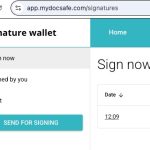Digital Signatures In A Post-Pandemic Landscape
Were wet signatures yet another victim of COVID-19?
The accelerating effect that the global pandemic had upon digital transformation (and indeed, upon digital customer interactions more generally) is undeniable. As lockdowns started to spread, digital signatures became an overnight necessity for many businesses – but their use threw issues of legality and validity into sharp focus.
In this article, we’ll explore what’s changed with regard to digital signatures in the wake of the Coronavirus pandemic, and most importantly, what the future holds for this method of digital authentication.
A Brief History Of Digital Signatures
While the pandemic may have made digital signatures a newly hot topic, the concept has been around since the mid 1970s. The research paper ‘New Directions in Cryptography,’ written by American cryptologists Whitfield Diffie and Martin Hellman, features concepts including public-key cryptography and digital signatures.
It took another year for the first practical application of the concept, as in 1977, a cryptosystem called the RSA algorithm used prime numbers, modulo operations, digital signatures, and much more to transmit data securely, winning the Turing Prize.
With the concept proven, many software providers started to develop solutions that brought digital signatures to market. At the turn of the millennium, President Bill Clinton passed the Electronic Signature in Global and National Commerce Act (ESIGN) which gave digital signatures the same legal value as a traditional signature.
Today, the exact definition of an electronic signature varies depending on jurisdiction. Typically, an advanced electronic signature requiring that:
- The signatory can be uniquely identified and linked to the signature
- The signatory must have sole control of the private key that was used to create the electronic signature
- The signature must be capable of identifying if its accompanying data has been tampered with after the message was signed
- In the event that the accompanying data has been changed, the signature must be invalidated[7]
A qualified signature goes one step further: the keys have to be distributed through a qualified provider and historically required a piece of hardware to hold those keys.
What’s next for digital signatures? Here at MyDocSafe, we’d like to venture a hypothesis that with the advent of biometric technology, the days of qualified signatures might be numbered because advanced signatures armed with biometric authentication will provide superior user experience and equivalent security.
Acceptance Of Digital Signatures – What Was The Impact Of The Pandemic?
The pandemic represented an unprecedented “forcing function’ when it came to digital signatures. The acceleration of digital transformation was notable in many previously analog processes, and with wet signatures “unworkable” interest in the adoption of digital signatures lept.
In the US, modernization of the legislation surrounding digital signatures was expedited by the pandemic. The E-SIGN Modernization Act will see a more streamlined process for consumers receiving electronic documents.
In the UK, a Government Ministerial Statement was issued at the start of March 2020 (as the country went into lockdown,) supporting the Law Commission’s ‘Electronic Execution of Documents’ report’s finding that “electronic signatures can be used to execute documents provided that there is an intention to authenticate and that any execution formalities are satisfied.”
Pre-pandemic, virtual signings followed Mercury signing protocols. These protocols had been in use since the 2008 Mercury Tax Group court case and were well established. However, they were still reliant on the emailing, printing and wet ink signing of documents by signatories, with signed pages being rescanned for their return.
In lockdown, it quickly became apparent that not everyone would have access to print and scan technology in their homes (and with supply chains grinding to a halt, no way of obtaining any!) As a result, there was a leap in the acceptance and use of trusted eSigning platforms – third party solutions which digitize (and validate) the entire signing process.
To get some idea of how quickly this technology was embraced following lockdown – the digital signature market was valued at $1.20 billion in 2019, but is now projected to reach $3.97 billion by 2024.
The Future Of Digital Signatures Post-Pandemic
When it comes to digital signatures, the genie is well and truly out of the bottle. A return to wet signatures seems unlikely as digital signatures benefit all parties involved. From faster deal progression to more efficient workflows, digital signatures have brought many benefits to enterprises and their clients.
However, as adoption spreads, we can reasonably expect regulation to tighten. Having glimpsed a world in which we were fully dependent on a digital process (if only for a short while) it seems as though stricter protocol and legislation will inevitably follow.
The pandemic also highlighted a need for more public awareness around the legality of digital signatures. There are still certain digital signing procedures which struggled to become “pandemic proof” such as the transfer of deeds, which still require a witness to be physically present at the time of signing – a necessity that obviously represented something of a challenge during strict household lockdowns!
However, the needle is starting to move, even here. In 2020, UK legislation surrounding wills and codicils changed to accommodate difficulties presented by lockdown. As a result, wills are now able to be witnessed electronically, via video call.
As the market and scope for the application of digital signatures grows, so too does the need to be selective about the platform that you choose to partner with. MyDocSafe offers some of the easiest, safest and fastest digital signing technology available on today’s market.
Tips For Digital Signature Best Practice
When looking to adopt digital signature protocols successfully within your own business, there are a few best practices that we would recommend following.
Work with a reliable and recognised platform
Not only does this help to guarantee a dependable service and digital service, you’ll also benefit from the trust that recognition of a familiar name establishes with your clients.
Client education
Although digital signatures are much more commonplace today, it’s still good practice to provide reassurance to clients in the legality and validity of the process.
Automate permission flows
Multi Step approval can be helpful when looking to collect a number of signatures that are interdependent upon a chain of authority. MyDocSafe makes it easy to create permission flows that automatically advances documents to the next relevant signatory.
Top level security practices
It goes without saying that security must be of paramount importance when working with digital signatures. For added reassurance, you might like to add extra security features to the process, such two-factor authentication with SMS codes, or escrowing private encryption keys with a reputable third party (all available from MyDocSafe.)
Ease of inclusion
The beauty of digital signatures lies in their convenience, so be sure to work with a solution that enables the easy addition of signing functionality to customisable eForms.
Digital Signatures: Big Opportunities, Growing Expectations…
Even before the impact of Covid, digital signatures represented a real opportunity to improve customer experience and operational efficiency. The impact of the pandemic has only increased consumer expectations when it comes the ease and convenience of digital signing – and today it’s up to enterprises to up their game and meet these expectations.
MyDocSafe’s combination of best-in-class security and high levels of customisable functionality can be instrumental in providing all the key benefits that digital signatures offer: a better experience for your customers and more efficient workflows for your business.
Deliver a secure, seamless digital signature experience – and so much more.


